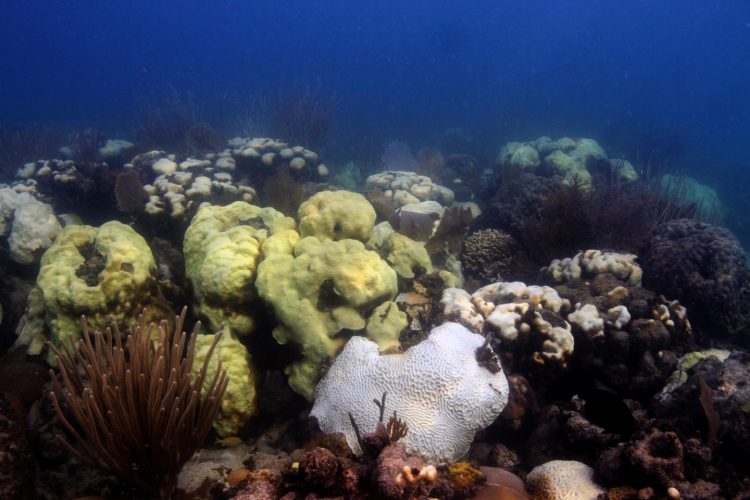NOAA study provides detailed projections of coral bleaching

Warmer water is causing coral to bleach as depicted here in an area of the Florida Keys called Cheeca Rocks. Credit: NOAA
While research shows that nearly all coral reef locations in the Caribbean and Gulf of Mexico will experience bleaching by mid-century, a new study showing in detail when and where bleaching will occur shows great variety in the timing and location of these harmful effects.
The new research published today in Global Change Biology by NOAA scientists and colleagues provides the first fine-scale projections of coral bleaching, an important planning tool for managers.
“Our new local-scale projections will help resource managers better understand and plan for the effects of coral bleaching,” said lead author Ruben van Hooidonk, a coral and climate researcher with the Cooperative Institute for Marine and Atmospheric Studies at the University of Miami's Rosenstiel School and NOAA's Atlantic Oceanographic and Meteorological Laboratory.
“At some locations, referred to in our study as 'relative refugia,' lower rates of temperature increase and fewer extreme events mean reefs have more time to adapt to climate change,” he said. “Managers may decide to use this information to protect these locations as refuges or protected areas. Or they may take other actions to reduce stress caused by human activities.”
Coral bleaching, which is primarily caused by warming ocean temperatures, is a major threat to our ocean's health. When water is too warm corals expel the algae living in their tissue, causing the coral to lose its vibrant colors and turn completely white. Bleached corals are under more stress and are more likely to die. Extensive coral bleaching events have increased in frequency and severity over the past two decades due to climate change.
The loss of coral reefs can have economic, social and ecological effects. Coral reefs provide rich habitat for valuable fisheries that people depend on for food. They serve as protective buffers to coastlines by absorbing wave energy from storms, and they boost local economies by attracting tourists who fish, dive and explore these underwater treasures.
The new bleaching projections build upon a previous study that used global climate models from the Fifth Assessment Report of the Intergovernmental Panel on Climate Change to produce projections at a very coarse resolution of about 68 miles or 110 kilometers. By using a regional ocean model and an approach called statistical downscaling, scientists calculated the onset of annual severe bleaching at a much higher resolution – 6 miles or 10 kilometers. The resulting local-scale projections of bleaching conditions will help managers include climate change as a consideration in planning and conservation decisions.
There are regions within many countries where some reefs are projected to experience annual bleaching conditions 15 or more years later than neighboring regions. This applies to reefs in Florida, the Bahamas, Cuba, Puerto Rico, the Dominican Republic, Turks and Caicos, and Mexico. Reefs projected to experience bleaching conditions later can be conservation priorities.
Scientists also compared the two approaches they used to produce the high-resolution projections and found that both methods produced similar results. This gives the team confidence that the more cost-effective and less labor-intensive statistical downscaling approach could be applied for all of the world's coral reefs, which the team plans to undertake over the coming year.
Bob Glazer of Florida's Fish and Wildlife Conservation Commission said he welcomed the new research. “Coral bleaching poses a grave threat to coral reefs and these high-resolution projections provide vitally needed spatial information about the degree of threat and will help us make better management decisions.”
###
NOAA's Reef Manager's Guide, which provides information on the causes and consequences of coral bleaching, outlines some of the management strategies and tools that can help reef managers address the coral bleaching threat. Find out more at http://www.
This study was funded by NOAA's Coral Reef Conservation Program and supported by NOAA AOML. The article has been published Open Access ensuring everyone interested can review the local-scale projections of bleaching conditions.
The paper, “Downscaled projections of Caribbean coral bleaching that can inform conservation planning,” can be read online at: http://onlinelibrary.
Media Contact
All latest news from the category: Earth Sciences
Earth Sciences (also referred to as Geosciences), which deals with basic issues surrounding our planet, plays a vital role in the area of energy and raw materials supply.
Earth Sciences comprises subjects such as geology, geography, geological informatics, paleontology, mineralogy, petrography, crystallography, geophysics, geodesy, glaciology, cartography, photogrammetry, meteorology and seismology, early-warning systems, earthquake research and polar research.
Newest articles

NASA: Mystery of life’s handedness deepens
The mystery of why life uses molecules with specific orientations has deepened with a NASA-funded discovery that RNA — a key molecule thought to have potentially held the instructions for…

What are the effects of historic lithium mining on water quality?
Study reveals low levels of common contaminants but high levels of other elements in waters associated with an abandoned lithium mine. Lithium ore and mining waste from a historic lithium…

Quantum-inspired design boosts efficiency of heat-to-electricity conversion
Rice engineers take unconventional route to improving thermophotovoltaic systems. Researchers at Rice University have found a new way to improve a key element of thermophotovoltaic (TPV) systems, which convert heat…



